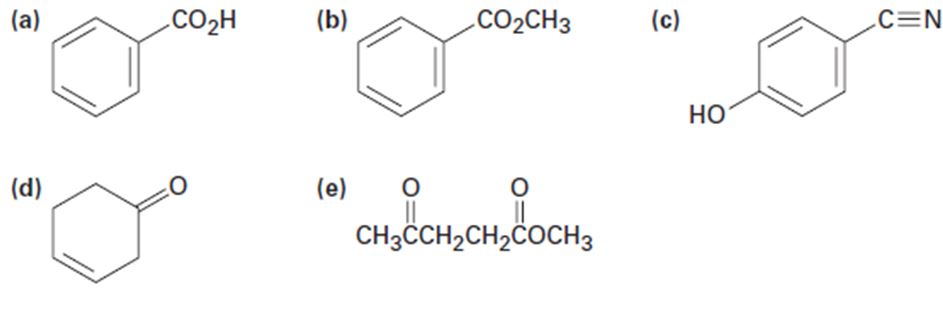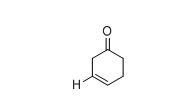
Concept explainers
At what approximate positions might the following compounds show IR absorptions?

a)
Interpretation:
The approximate absorption frequency has to be given for compound.
Concept introduction:
Spectroscopy: It is study of the interaction of matter and electromagnetic radiation, a continuum of different types of electromagnetic radiation each associated with a particular energy range makes up the electromagnetic spectrum.
IR frequency (cm-1): It is the number of wave crests that pass by a given point in one second frequency has units of hertz (Hz).
Stretch vibrations: It is a vibration occurring along the line of the bond a stretching vibration changes the bond length.
Bending vibrations: It is a vibration that does not occur along the line of the bond, bending vibration changes the bond angle.
Answer to Problem 33AP
The IR absorptions values at 1450-1600 cm-1 is for carbon double bond carbon stretching frequency, 3030 cm-1 is for aromatic carbon hydrogen stretching frequency, 1710-1760 cm-1 is for acid carbonyl frequency and 2500-3100 cm-1 is for acid hydroxyl frequency.
Explanation of Solution
Given information:
The approximate absorption frequency for the given compound,

The IR absorptions values at 1450-1600 cm-1 is for carbon double bond carbon stretching frequency, 3030 cm-1 is for aromatic carbon hydrogen stretching frequency, 1710-1760 cm-1 is for acid carbonyl frequency and 2500-3100 cm-1 is for acid hydroxyl frequency.
Therefore, the approximate absorption frequency for the given compound is shown below,

The approximate absorption frequency is given for compound.
b)
Interpretation:
The approximate absorption frequency has to be given for compound.
Concept introduction:
Spectroscopy: It is study of the interaction of matter and electromagnetic radiation, a continuum of different types of electromagnetic radiation each associated with a particular energy range makes up the electromagnetic spectrum.
IR frequency (cm-1): It is the number of wave crests that pass by a given point in one second frequency has units of hertz (Hz).
Stretch vibrations: It is a vibration occurring along the line of the bond a stretching vibration changes the bond length.
Bending vibrations: It is a vibration that does not occur along the line of the bond, bending vibration changes the bond angle.
Answer to Problem 33AP
The IR absorptions values at 1450-1600 cm-1 is for carbon double bond carbon stretching frequency, 3030 cm-1 is for aromatic carbon hydrogen stretching frequency, 1710-1760 cm-1 is for acid carbonyl frequency and 2500-3100 cm-1 is for acid hydroxyl frequency.
Explanation of Solution
Given information:
The approximate absorption frequency for the given compound,

The IR absorptions values at 1450-1600 cm-1 is for carbon double bond carbon stretching frequency, 3030 cm-1 is for aromatic carbon hydrogen stretching frequency, 1710-1760 cm-1 is for acid carbonyl frequency and 2500-3100 cm-1 is for acid hydroxyl frequency.
Therefore, the approximate absorption frequency for the given compound is shown below,

The difference between given pairs of isomers is explained by using infrared spectroscopy.
c)
Interpretation:
The difference between given pairs of isomer has to be explained by using infrared spectroscopy.
Concept introduction:
Spectroscopy: It is study of the interaction of matter and electromagnetic radiation, a continuum of different types of electromagnetic radiation each associated with a particular energy range makes up the electromagnetic spectrum.
IR frequency (cm-1): It is the number of wave crests that pass by a given point in one second frequency has units of hertz (Hz).
Stretch vibrations: It is a vibration occurring along the line of the bond a stretching vibration changes the bond length.
Bending vibrations: It is a vibration that does not occur along the line of the bond, bending vibration changes the bond angle.
Answer to Problem 33AP
The IR absorptions values at 1450-1600 cm-1 is for carbon double bond carbon stretching frequency, 3030 cm-1 is for aromatic carbon hydrogen stretching frequency, 2210-2260 cm-1 is for acid carbonyl frequency and 3400-3650 cm-1 is for acid hydroxyl frequency.
Explanation of Solution
Given information:
The approximate absorption frequency for the given compound,

The IR absorptions values at 1450-1600 cm-1 is for carbon double bond carbon stretching frequency, 3030 cm-1 is for aromatic carbon hydrogen stretching frequency, 2210-2260 cm-1 is for acid carbonyl frequency and 3400-3650 cm-1 is for acid hydroxyl frequency.
Therefore, the approximate absorption frequency for the given compound is shown below,

The difference between given pairs of isomers is explained by using infrared spectroscopy.
d)
Interpretation:
The difference between given pairs of isomer has to be explained by using infrared spectroscopy.
Concept introduction:
Spectroscopy: It is study of the interaction of matter and electromagnetic radiation, a continuum of different types of electromagnetic radiation each associated with a particular energy range makes up the electromagnetic spectrum.
IR frequency (cm-1): It is the number of wave crests that pass by a given point in one second frequency has units of hertz (Hz).
Stretch vibrations: It is a vibration occurring along the line of the bond a stretching vibration changes the bond length.
Bending vibrations: It is a vibration that does not occur along the line of the bond, bending vibration changes the bond angle.
Answer to Problem 33AP
The IR absorptions values at 1640-1680 cm-1 is for carbon double bond carbon stretching frequency, 3020-3100 cm-1 is for vinylic carbon hydrogen stretching frequency and 1715 cm-1 is for acid hydroxyl frequency.
Explanation of Solution
Given information:
The approximate absorption frequency for the given compound,

The IR absorptions values at 1640-1680 cm-1 is for carbon double bond carbon stretching frequency, 3020-3100 cm-1 is for vinylic carbon hydrogen stretching frequency and 1715 cm-1 is for acid hydroxyl frequency.
Therefore, the approximate absorption frequency for the given compound is shown below,

The difference between given pairs of isomers is explained by using infrared spectroscopy.
e)
Interpretation:
The difference between given pairs of isomer has to be explained by using infrared spectroscopy.
Concept introduction:
Spectroscopy: It is study of the interaction of matter and electromagnetic radiation, a continuum of different types of electromagnetic radiation each associated with a particular energy range makes up the electromagnetic spectrum.
IR frequency (cm-1): It is the number of wave crests that pass by a given point in one second frequency has units of hertz (Hz).
Stretch vibrations: It is a vibration occurring along the line of the bond a stretching vibration changes the bond length.
Bending vibrations: It is a vibration that does not occur along the line of the bond, bending vibration changes the bond angle.
Answer to Problem 33AP
The IR absorptions values at 1715 cm-1 is for carbonyl (ketone) stretching frequency and 1735 cm-1 is for carbonyl ester frequency.
Explanation of Solution
Given information:
The approximate absorption frequency for the given compound,

The IR absorptions values at 1715 cm-1 is for carbonyl (ketone) stretching frequency and 1735 cm-1 is for carbonyl ester frequency.
Therefore, the approximate absorption frequency for the given compound is shown below,

The difference between given pairs of isomers is explained by using infrared spectroscopy.
Want to see more full solutions like this?
Chapter 12 Solutions
ORGANIC CHEMISTRY W/OWL
- Draw a tetramer of this alternating copolymer.arrow_forwardH I T H HH H -H C. H- Identify and select all structures below that represent a constitutional isomer(s) of the compound shown above. H- H CIH H H H HHHH H H 0 ·H H– 冊 CH CHI HH C- H- H H- H H A. H H C H H- -H HH H B. H- -H D. H H H H • H -H E. -H H H HICH T HHH F. H-arrow_forwardPolylactic acid (shown below) is a biodegradable polymer used for food packaging. Identify the monomer(s) used in the production of this polymer using a condensation process.arrow_forward
- Draw the product of the reaction shown below. Ignore small byproducts that would evaporate pleasearrow_forwardPoly(ethylene adipate) is a biodegradable polyester (shown below). Identify the type of polymerization process used in the production of this polymer.arrow_forwardPolymers may be composed of thousands of monomers. draw two repeat units(dimer) of the polymer formed in this reaction. assume there are hydrogen atoms on the two ends of the dimer. ignore inorganic byproducts pleasearrow_forward
- Draw the product of the reaction shown below. Use a dash or wedge bond to indicate stereochemistry of substituents on asymmetric centers, Ignore inorganic byproductsarrow_forwardDraw the product of this reaction please. Ignore inorganic byproductsarrow_forwardOne of the pi molecular orbitals of 1,3-butadiene (CH2=CHCH=CH2) is shown below. Please identify the number of nodal planes perpendicular to the bonding axisarrow_forward
- Draw the monomers required to synthesize this condensation polymer please.arrow_forwardProvide the correct systematic name for the compound shown here. Please take into account the keyboard options belowarrow_forwardcurved arrows are used to illustrate the flow of electrons. using the provided starting and product structures, draw the curved electron-pushing arrows for the following reaction or mechanistic step(s)arrow_forward

 Organic Chemistry: A Guided InquiryChemistryISBN:9780618974122Author:Andrei StraumanisPublisher:Cengage Learning
Organic Chemistry: A Guided InquiryChemistryISBN:9780618974122Author:Andrei StraumanisPublisher:Cengage Learning Organic ChemistryChemistryISBN:9781305580350Author:William H. Brown, Brent L. Iverson, Eric Anslyn, Christopher S. FootePublisher:Cengage Learning
Organic ChemistryChemistryISBN:9781305580350Author:William H. Brown, Brent L. Iverson, Eric Anslyn, Christopher S. FootePublisher:Cengage Learning


